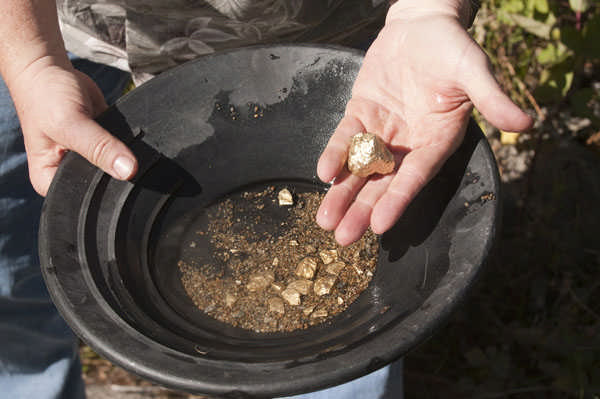As always, I was stumped this year for a Christmas present for my fishing buddy Chuck, who makes plenty of money and can buy whatever he wants. Chuck and his wife, Liz, own a cabin on Indiana’s Eel River, one of the best smallmouth-bass fisheries in the state, where I like to be invited to fish, often.
Something for the cabin, I thought. Maybe a Les Kouba wildlife art print. Kouba once told me he didn’t know why he always put 13 birds in his paintings. He just did. An artist’s obsession, he said.
Liz, too, has an artistic obsession. Hers is for bear-themed cabin tchotchkes. Chuck tolerates this, but does not wish to encourage it. So no bear light switches or kitchen canisters.
Above their cabin fireplace is a framed collection of arrowheads Chuck has found along the Eel River.
He’s also done some research on the Potawatomi people. Maybe he’d like some information about the geology of the land where his cabin sits on the high-side limestone riverbank.
In pre-Google Earth days, I owned a cabin in the coulees of the Minnesota River Valley. A friend back then gave me a framed aerial shot of the river valley along with a geological explanation of how it was created: In the last Ice Age, Lake Agassiz, a glacial lake covering southern Manitoba as well as parts of northern Minnesota and North Dakota, overran a natural rock dam, allowing billions of gallons of water to gush south through the present Red River Valley into southern Minnesota. After the torrent of water scoured out a raging five-mile-wide river there, the receding water left behind steep fingers of deeply eroded river banks that the early French trappers called “coulees.” My cabin sat on the highest point of one of these coulees.
I know all of that information because my thoughtful friend included it with his gift of the aerial photograph. It was a very cool present.
Something for the cabin, I thought. Maybe a Les Kouba wildlife art print. Kouba once told me he didn’t know why he always put 13 birds in his paintings. He just did. An artist’s obsession, he said.
Liz, too, has an artistic obsession. Hers is for bear-themed cabin tchotchkes. Chuck tolerates this, but does not wish to encourage it. So no bear light switches or kitchen canisters.
Above their cabin fireplace is a framed collection of arrowheads Chuck has found along the Eel River.
He’s also done some research on the Potawatomi people. Maybe he’d like some information about the geology of the land where his cabin sits on the high-side limestone riverbank.
In pre-Google Earth days, I owned a cabin in the coulees of the Minnesota River Valley. A friend back then gave me a framed aerial shot of the river valley along with a geological explanation of how it was created: In the last Ice Age, Lake Agassiz, a glacial lake covering southern Manitoba as well as parts of northern Minnesota and North Dakota, overran a natural rock dam, allowing billions of gallons of water to gush south through the present Red River Valley into southern Minnesota. After the torrent of water scoured out a raging five-mile-wide river there, the receding water left behind steep fingers of deeply eroded river banks that the early French trappers called “coulees.” My cabin sat on the highest point of one of these coulees.
I know all of that information because my thoughtful friend included it with his gift of the aerial photograph. It was a very cool present.
Using Google Earth, I printed an aerial shot of Chuck’s cabin. Next I researched Indiana geology. Paraphrasing a lengthy professional paper, I described for Chuck how Mother Nature created the perfect limestone riverbed habitat for his smallmouth bass. Three hundred million years ago, shallow seas repeatedly flooded the area and receded, leaving behind broken shells and hard skeletal fragments of ancient marine life that formed multiple layers of sedimentary rock – what we call limestone. The last period of glaciation then filled north central Indiana with glacial drift, some of which contained small traces of gold.
Gold! Gold! I immediately went online and ordered a 15-inch Super Sluice Gold Pan for $10.
I framed up the Google Earth shot and the geological description. Before sealing the back with kraft paper, I shook a few Eel River pebbles out of my waders – without finding any gold nuggets – and sprinkled them across the documents.
I wrapped the gold pan in gold foil and tagged it with: “Merry Christmas, Chuck! Good luck panning. Maybe you’ll find some arrowheads.”
Paul Sullivan has never met a cabin he didn’t like.
Gold! Gold! I immediately went online and ordered a 15-inch Super Sluice Gold Pan for $10.
I framed up the Google Earth shot and the geological description. Before sealing the back with kraft paper, I shook a few Eel River pebbles out of my waders – without finding any gold nuggets – and sprinkled them across the documents.
I wrapped the gold pan in gold foil and tagged it with: “Merry Christmas, Chuck! Good luck panning. Maybe you’ll find some arrowheads.”
Paul Sullivan has never met a cabin he didn’t like.












